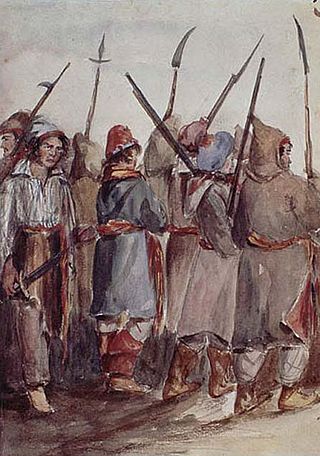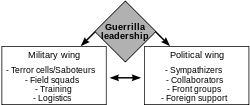
Conventional warfare is a form of warfare conducted by using conventional weapons and battlefield tactics between two or more states in open confrontation. The forces on each side are well-defined and fight by using weapons that target primarily the opponent's military. It is normally fought by using conventional weapons, not chemical, biological, radiological, or nuclear weapons.

Asymmetric warfare is a type of war between belligerents whose relative military power, strategy, or tactics differ significantly. This type of warfare often, but not necessarily, involves insurgents or resistance movement militias who may have the status of unlawful combatants against a standing army.

A low-intensity conflict (LIC) is a military conflict, usually localised, between two or more state or non-state groups which is below the intensity of conventional war. It involves the state's use of military forces applied selectively and with restraint to enforce compliance with its policies or objectives.
AirLand Battle was the overall conceptual framework that formed the basis of the US Army's European warfighting doctrine from 1982 into the late 1990s. AirLand Battle emphasized close coordination between land forces acting as an aggressively maneuvering defense, and air forces attacking rear-echelon forces feeding those front line enemy forces. AirLand Battle replaced 1976's "Active Defense" doctrine, and was itself replaced by "Full Spectrum Operations" in 2001.
Fourth-generation warfare (4GW) is conflict characterized by a blurring of the distinction between war and politics, and of the distinction between combatants and civilians.

Irregular military is any non-standard military component that is distinct from a country's national armed forces. Being defined by exclusion, there is significant variance in what comes under the term. It can refer to the type of military organization, or to the type of tactics used. An irregular military organization is one which is not part of the regular army organization. Without standard military unit organization, various more general names are often used; such organizations may be called a troop, group, unit, column, band, or force. Irregulars are soldiers or warriors that are members of these organizations, or are members of special military units that employ irregular military tactics. This also applies to irregular infantry and irregular cavalry units.

Modern warfare is warfare that diverges notably from previous military concepts, methods, and technology, emphasizing how combatants must modernize to preserve their battle worthiness. As such, it is an evolving subject, seen differently in different times and places. In its narrowest sense, it is merely a synonym for contemporary warfare.

Counterinsurgency is "the totality of actions aimed at defeating irregular forces". The Oxford English Dictionary defines counterinsurgency as any "military or political action taken against the activities of guerrillas or revolutionaries" and can be considered war by a state against a non-state adversary. Insurgency and counterinsurgency campaigns have been waged since ancient history. However, modern thinking on counterinsurgency was developed during decolonization.

The United States Army Civil Affairs and Psychological Operations Command (Airborne), USACAPOC(A), or CAPOC was founded in 1985 and is headquartered at Fort Liberty, North Carolina. USACAPOC(A) is composed mostly of U.S. Army Reserve Soldiers in units throughout the United States. The size of the Command is nearly 13,500 Soldiers, which is 76% of the Department of Defense's Civil Affairs forces and 63% of Psychological Operations forces. The current Commanding General is Major General Isaac Johnson Jr., who assumed command in August 2022.
The Doctrine for Joint Nuclear Operations is a U.S. Department of Defense document publicly discovered in 2005 on the circumstances under which commanders of U.S. forces could request the use of nuclear weapons. The document was a draft being revised to be consistent with the Bush doctrine of preemptive attack. The label "Joint" refers to the fact that it was endorsed by the five service branches of the American military as well as the US Joint Chiefs of Staff.

Psychological operations (PSYOP) are operations to convey selected information and indicators to audiences to influence their motives and objective reasoning, and ultimately the behavior of governments, organizations, groups, and large foreign powers.
The following outline is provided as an overview of and topical guide to military science:

Special reconnaissance (SR) is conducted by small units, such as a recon team, made up of highly trained military personnel, usually from special forces units and/or military intelligence organizations. Special reconnaissance teams operate behind enemy lines, avoiding direct combat and detection by the enemy. As a role, SR is distinct from commando operations, but both are often carried out by the same units. The SR role frequently includes covert direction of airstrikes and indirect fire, in areas deep behind enemy lines, placement of remotely monitored sensors, and preparations for other special forces. Like other special forces, SR units may also carry out direct action and unconventional warfare, including guerrilla operations.

Foreign internal defense (FID) is a term used by the military in several countries, including the United States, France, and the United Kingdom, to describe an integrated, or multi-country approach to combating actual or threatened insurgency in a foreign state. This foreign state is known as the Host Nation (HN) under the US doctrine. The term counter-insurgency is commonly used for FID.
National governments deal in both intelligence and military special operations functions that either should be completely secret, or simply cannot be linked to the sponsor. It is a continuing and unsolved question for governments whether clandestine intelligence collection and covert action should be under the same agency. The arguments for doing so include having centralized functions for monitoring covert action and clandestine HUMINT and making sure they do not conflict, as well as avoiding duplication in common services such as cover identity support, counterespionage, and secret communications. The arguments against doing so suggest that the management of the two activities takes a quite different mindset and skills, in part because clandestine collection almost always is on a slower timeline than covert action.
In United States military doctrine, unconventional warfare is one of the core activities of irregular warfare. Unconventional warfare is essentially support provided by the military to a foreign insurgency or resistance. The legal definition of UW is:
Unconventional Warfare consists of activities conducted to enable a resistance movement or insurgency to coerce, disrupt or overthrow an occupying power or government by operating through or with an underground, auxiliary or guerrilla force in a denied area.
The main strategy and tactics of guerrilla warfare tend to involve the use of a small attacking, mobile force against a large, unwieldy force. The guerrilla force is largely or entirely organized in small units that are dependent on the support of the local population. Tactically, the guerrilla army makes the repetitive attacks far from the opponent's center of gravity with a view to keeping its own casualties to a minimum and imposing a constant debilitating strain on the enemy. This may provoke the enemy into a brutal, excessively destructive response which will both anger their own supporters and increase support for the guerrillas, ultimately compelling the enemy to withdraw. One of the most famous examples of this was during the Irish War of Independence. Michael Collins, a leader of the Irish Republican Army, often used this tactic to take out squads of British soldiers, mainly in Munster, especially Cork.
Joint unconventional warfare is the inter-agency, or international implementation of an unconventional warfare strategy, comprising elements of asymmetric warfare, irregular warfare, urban warfare and various forms of psychological operations deployed by non-traditional means.
Free war is a form of guerrilla warfare that is conducted with cut-off smaller military units in enemy occupied territory. The largest difference between free war and guerrilla warfare is that free war is conducted by regular military forces, instead of paramilitary organizations or irregular military forces.











